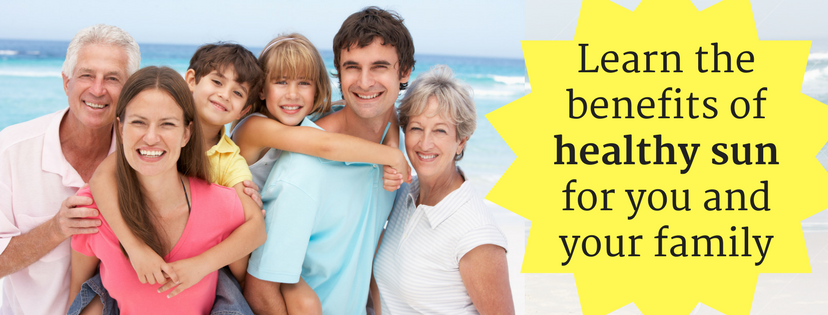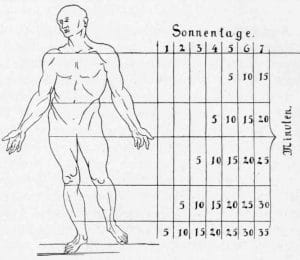
How is sunshine good for me?
Sun exposure is good for our bodies as long as we don’t burn. Sunshine exposed to our skin gives us vitamin D, lowers blood pressure, protects against future sun damage, boosts the immune system, relieves pain, promotes relaxation, heals wounds, and regulates circadian rhythm, just to name a few.
According to Dr. Pella Lindqvist, we also live longer when we use the sun sensibly and avoiding the sun carries the same risk factor for death as smoking.(1)
In the following short video, Dr. Michael Holick talks scientifically about the benefits of sunshine, besides the production of vitamin D. It makes beta-endorphins – improving your mood. It produces nitric oxide – lowering blood pressure. It makes 5-6 additional vitamin D-like photoproducts – which help with overall skin health. Watch Now
A vitamin D level within 40-60 ng/ml is associated with reduced incidence of many diseases such as cancer, MS, diabetes, and more.
Why have we been told to stay out of the sun? Or to use sunscreen? Or to cover up?
That recommendation comes from the risk of skin cancer and melanoma. Listen to this TED talk by Dr. Richard Weller titled, “Could the Sun Be Good for Your Heart?“. He argues that while there is a chance of getting skin cancer, sunshine provides vitamin D and other benefits that lower your risk of all cancers. Would it be better to have some skin cut off when you are 60? Or get breast cancer when you are 40?
According to a 2012 study, the risk of melanoma is based on the following criteria: hair color, Fitzpatrick skin type, freckling, family history of melanoma, total-body nevus count, large nevi (> 5mm), sunburn history. Take this online quiz from the Harvard School of Public Health to assess your risk of melanoma.
In another short video, Dr. Robert Heaney, GrassrootsHealth Research Director, answers the question “Is it OK to go out in the sun without sunscreen?” He says, “Yes!” He describes how natural it is to go outside in small doses and get sunshine, to enjoy the outdoors. Watch Now
All in or all out?
Typically things aren’t that black or white. While sun exposure could cause skin cancer or melanoma, avoiding the sun could put you at risk for a slew of other diseases. The best bet is to understand how to get sensible sun exposure – to not burn.
A healthy life includes sunshine. Enjoying the sun safely, while taking care not to burn, can help to provide the benefits of vitamin D without unduly raising the risk of skin cancer. The following are the three factors to take into consideration before going out in the sun.
Skin Type
Skin type is very important when planning your sun exposure. The statement that “15-30 minutes of midday sun is plenty” is just NOT TRUE for many people. That might be true if you are a Fitzpatrick skin type II. It is definitely NOT TRUE you are a Fitzpatrick skin type VI.
UV Strength
You can spend time outdoors at 7pm and be guaranteed never to burn. Why? The UV strength is minimal or non-existent at that time (in most parts of the globe). Understand your latitude, the time of year, and the time of solar noon. Cloud cover, smog, altitude all affect UV strength. The higher the UV strength – the shorter your time in the sun.
Duration
 Figure out your goal sunshine time based on the amount of vitamin D you would like to get, UV strength, how much body you are exposing, and your skin type. If you haven’t been out in the sun for several months (over a long winter), don’t try to take it all in at once. Work slowly and acclimate your skin to the sun over time, as explained in the acclimation chart.
Figure out your goal sunshine time based on the amount of vitamin D you would like to get, UV strength, how much body you are exposing, and your skin type. If you haven’t been out in the sun for several months (over a long winter), don’t try to take it all in at once. Work slowly and acclimate your skin to the sun over time, as explained in the acclimation chart.
Dr. Alexander Wunsch presented this chart in a presentation on the history of sun therapy. This illustration demonstrates how light therapists gradually acclimate the body to light (sun or lamp). Session 1 you only expose the feet to 5 minutes of light. Session 2, after 5 minutes of exposure only on the feet, a blanket is raised to expose the lower leg along with the feet for an additional 5 minutes, and so on. This is a very gradual process.
Check Your Vitamin D Levels Today!
Videos
Papers
- Sunlight and Vitamin D: Necessary for Public Health
– paper by GrassrootsHealth - Sunlight Has Cardiovascular Benefits Independently of Vitamin D
– research paper by Richard Weller - Sunlight and Vitamin D: A global perspective for health
– paper by Matthias Wacker and Michael F. Holick, published in Dermato Endocrinology in 2013 - Sun is good for you – you may live longer, study finds
– press release by the Vitamin D Society- The lead author Dr. Pelle Lindqvist concludes “We found smokers in the highest sun exposure group were at a similar risk as non-smokers avoiding sun exposure, indicating avoidance of sun exposure to be a risk factor of the same magnitude as smoking.”
- Avoidance of sun exposure as a risk factor for major causes of death: a competing risk analysis of the Melanoma in Southern Sweden cohort
– abstract of the study on PubMed
- Sunlight: For Better or For Worse? A Review of Positive and Negative Effects of Sun Exposure
– summary of recent research on the health effects of sun exposure and the possibly involved mechanisms, published May of 2016 - The risks and benefits of sun exposure 2016, David G. Hoel et al.
- Biological Effects of Sunlight, Ultraviolet Radiation, Visible Light, Infrared Radiation and Vitamin D for Health, Michael F. Holick, Ph.D., M.D.
- Concurrent beneficial (vitamin D production) and hazardous (cutaneous DNA damage) impact of repeated low‐level summer sunlight exposures, S.J. Felton et al.
Check Your Vitamin D Levels Today!
